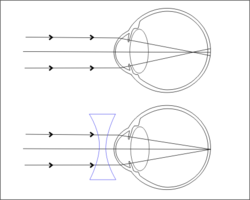Nearsightedness
From WikiLectures
Nearsightedness, also called myopia is a condition where the nearsighted eye has a distant point, punctum remotum, at a final distancein frontof the eye. Parallel rays coming to the eye are refracted into the focus point, which is in front of the retina. The main manifestation is poor visibility of distant objects.
The correction is performed with glasses with a dispersion lens, which has a negative dioptric value.
There are two causes that lead to myopia:
- axial – the eyeball is too long (it is a congenital defect, explained by fluctuations in the dimensions of the eye formed in embryonic development);
- refractive – the eyeball has a normal length, but greater refraction of optical environments. This cause of myopia is not so common.
Presbyopia occurs later in myopes and is not so striking because the loss of accomodation is partly compensated by a refractive error.
- Myopia
Links[edit | edit source]
Related articles[edit | edit source]
- Farsightedness (hypermetropia)
- Biochemistry of the vision process
- Eye (biophysics)
- Eye (biophysics)/Disorders of the eye
- Optical apparatus of the eye, oculomotor muscles, eye movements
- Eye (histology)
Source[edit | edit source]
- KYMPLOVÁ, Jaroslava. Katalog metod v biofyzice [online]. [cit. 2012-09-20]. <https://portal.lf1.cuni.cz/clanek-793-katalog-metod-v-biofyzice>.



